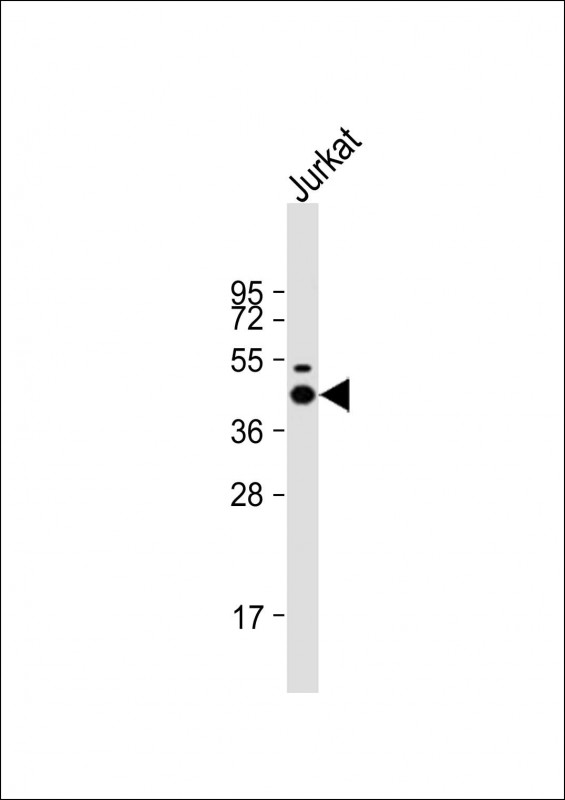Mouse anti-LCK Monoclonal Antibody(1526CT823.75.16)描述别名宿主特异性反应种属应用分子量类型克隆号同种型储存/保存方法研究领域背景说明细胞定位UniProt参考文献
| 概述 | |
| 描述 |
Purified Mouse Monoclonal Antibody (Mab)
|
| 别名 |
LCK抗体;Tyrosine-protein kinase Lck; Leukocyte C-terminal Src kinase; LSK; Lymphocyte cell-specific protein-tyrosine kinase; Protein YT16; Proto-oncogene Lck; T cell-specific protein-tyrosine kinase; p56-LCK; LCK
|
| 宿主 |
Mouse
|
| 特异性 |
This LCK antibody is generated from a mouse immunized with a recombinant protein.
|
| 反应种属 |
Human
|
| 应用 |
IF~~1:25
FC~~1:25 IHC-P~~1:25 WB~~1:2000 |
| 分子量 |
Predicted molecular weight: 58kD
Disclaimer note: The observed molecular weight of the protein may vary from the listed predicted molecular weight due to post translational modifications, post translation cleavages, relative charges, and other experimental factors. |
| 性能 | |
| 类型 |
Monoclonal Antibody
|
| 克隆号 |
1526CT823.75.16
|
| 同种型 |
IgG1,k
|
| 储存/保存方法 |
Maintain refrigerated at 2-8°C for up to 2 weeks. For long term storage store at -20°C in small aliquots to prevent freeze-thaw cycles.
|
| 研究领域 |
Immunology;Signal Transduction
|
| 靶标 | |
| 背景说明 |
Non-receptor tyrosine-protein kinase that plays an essential role in the selection and maturation of developing T- cells in the thymus and in the function of mature T-cells. Plays a key role in T-cell antigen receptor (TCR)-linked signal transduction pathways. Constitutively associated with the cytoplasmic portions of the CD4 and CD8 surface receptors. Association of the TCR with a peptide antigen-bound MHC complex facilitates the interaction of CD4 and CD8 with MHC class II and class I molecules, respectively, thereby recruiting the associated LCK protein to the vicinity of the TCR/CD3 complex. LCK then phosphorylates tyrosines residues within the immunoreceptor tyrosine-based activation motifs (ITAM) of the cytoplasmic tails of the TCR-gamma chains and CD3 subunits, initiating the TCR/CD3 signaling pathway. Once stimulated, the TCR recruits the tyrosine kinase ZAP70, that becomes phosphorylated and activated by LCK. Following this, a large number of signaling molecules are recruited, ultimately leading to lymphokine production. LCK also contributes to signaling by other receptor molecules. Associates directly with the cytoplasmic tail of CD2, which leads to hyperphosphorylation and activation of LCK. Also plays a role in the IL2 receptor-linked signaling pathway that controls the T-cell proliferative response. Binding of IL2 to its receptor results in increased activity of LCK. Is expressed at all stages of thymocyte development and is required for the regulation of maturation events that are governed by both pre-TCR and mature alpha beta TCR. Phosphorylates other substrates including RUNX3, PTK2B/PYK2, the microtubule-associated protein MAPT, RHOH or TYROBP.
|
| 细胞定位 |
Cytoplasm. Cell membrane; Lipid-anchor; Cytoplasmic side. Note=Present in lipid rafts in an inactive form
|
| UniProt |
P06239
|
| 参考文献 | |
| 参考文献 |
Koga Y.,et al.Eur. J. Immunol. 16:1643-1646(1986).
Perlmutter R.M.,et al.J. Cell. Biochem. 38:117-126(1988). Rouer E.,et al.Gene 84:105-113(1989). Wright D.D.,et al.Mol. Cell. Biol. 14:2429-2437(1994). Vogel L.B.,et al.Biochim. Biophys. Acta 1264:168-172(1995). |
实验结果图

Anti-LCK Antibody at 1:2000 dilution + Jurkat whole cell lysate Lysates/proteins at 20 μg per lane. Secondary Goat Anti-mouse IgG, (H+L), Peroxidase conjugated at 1/10000 dilution. Predicted band size : 58 kDa Blocking/Dilution buffer: 5% NFDM/TBST.
